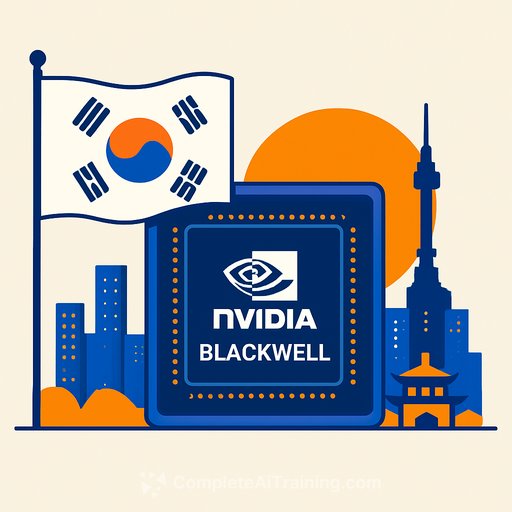South Korea's AI ambition meets Blackwell-class chips: a strategy brief for executives
South Korea is moving fast to scale national AI capacity. At the center is a push to secure next-generation accelerators based on NVIDIA's Blackwell architecture and build the domestic infrastructure, talent, and policy needed to put them to work.
If you lead strategy or capital allocation, the question isn't "if" you need a compute plan - it's "how" to deploy it without wasting time or budget. Here's the executive playbook.
Why this matters now
- Compute access defines pace: Model quality, iteration speed, and unit economics are now compute-bound. Securing reliable capacity is a competitive moat.
- Ecosystem advantage: Korea brings memory giants, fabs, telcos, and platform leaders under one roof. Coordinated moves compress timelines.
- Capital efficiency: The cost per token trained and served is the new gross margin lever. Hardware choice and workload placement decide it.
- Policy tailwinds: National programs will favor projects that create jobs, data assets, and exportable IP - not just GPU burn.
What Blackwell-class chips actually change
Blackwell is built for large foundation models and high-throughput inference. Expect better performance per watt, bigger effective memory, faster interconnects, and formats that lower cost without wrecking accuracy.
Translation: shorter training cycles, cheaper serving at scale, and headroom for multimodal workloads. For a technical overview, see NVIDIA's architecture brief here.
Decisions to make in the next 90 days
- Procurement model: Blend options - direct purchase for steady core workloads, reserved cloud instances for bursts, and colocation for custom stacks. Negotiate cancellation rights and upgrade paths keyed to Blackwell availability.
- Capacity planning: Map model roadmap to compute needs. Size training, fine-tuning, and inference separately. Aim for 65-80% sustained utilization with buffer for R&D spikes.
- Workload placement: Keep sensitive training on domestic capacity; put inference near users to cut latency. Use autoscaling for spiky consumer apps, fixed clusters for internal platforms.
- Model strategy: Default to fine-tuning proven base models. Train from scratch only when data uniqueness is a durable edge and TCO pencils out.
- Vendor mix: Blackwell for frontier workloads; mix prior-gen GPUs for fine-tunes and inference. Track timelines from domestic suppliers to reduce single-vendor risk.
- Data engine: Budget for curation, labeling, evals, and retrieval pipelines. Models depreciate; first-party data compounds.
Infrastructure and energy: design for cost and reliability
High-density racks, liquid cooling, and grid planning are no longer optional. Facility choices will make or break your cost curve.
- Target low PUE sites and plan for liquid cooling upgrades early. Retrofitting later is more expensive.
- Lock multi-year energy contracts with price bands and demand response clauses. Secure transformer and switchgear lead times now.
- Co-locate near fiber and peering points to shrink egress bills and latency for inference.
Supply chain and policy risk
Lead times, export regimes, and component shortages can stall programs. Treat them as core planning inputs, not afterthoughts.
- Stage deployments by quarter, with alternates for delays. Keep a second source for memory, networking, and cooling.
- Align with national incentives and data rules to qualify for support and avoid rework.
Team and operating model
You don't need a giant research lab. You need a small, senior team with clear interfaces to product and IT.
- Key roles: infrastructure lead (GPU clusters), data platform lead, applied research lead, product owners, security/governance lead.
- Stand up a cross-functional AI Council to approve use cases, budgets, and risk controls. Review monthly.
- Upskill managers and ICs on model selection, prompt orchestration, and evaluation. Curated programs are a fast path - see AI courses by job for structured options.
Governance, safety, and compliance
Set guardrails before scale. Retrofits are costly and political.
- Data policy: classify sources, consent, and retention. Keep a record of training data lineage and licenses.
- Model policy: pre-deployment evals for bias, privacy, security, and factuality; red-team high-risk use cases.
- Operations: monitor for prompt injection, jailbreaks, and data leakage. Log prompts and outputs with user consent and retention limits.
Metrics that actually matter
- Cost per 1M tokens trained and per 1M tokens served
- Queue time to first experiment and to production
- GPU utilization by workload class
- Bug-to-fix cycle time on model regressions
- Business lift per model (conversion, churn, AHT, NPS)
Action checklist
- Lock a 12-18 month compute plan with staged Blackwell access and fallbacks.
- Prioritize 3-5 high-ROI use cases and kill the rest for now.
- Build a shared feature store and retrieval layer fed by clean first-party data.
- Standardize evals and acceptance criteria across teams.
- Secure energy, cooling, and network upgrades before hardware lands.
- Negotiate vendor terms: delivery windows, support SLAs, upgrade credits.
- Stand up the AI Council and publish a one-page governance policy.
- Launch an internal talent sprint; certify leads within 60 days via focused programs.
Bottom line
South Korea's push sets a clear signal: compute, data, and disciplined execution decide winners. Move now to secure capacity, build the data engine, and install the operating system your teams need to deliver measurable outcomes.
Speed matters, but judgment matters more. Keep the plan simple, metrics tight, and teams small - and ship things your customers actually use.
Your membership also unlocks:






